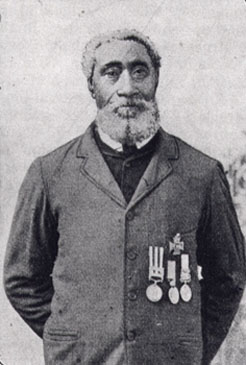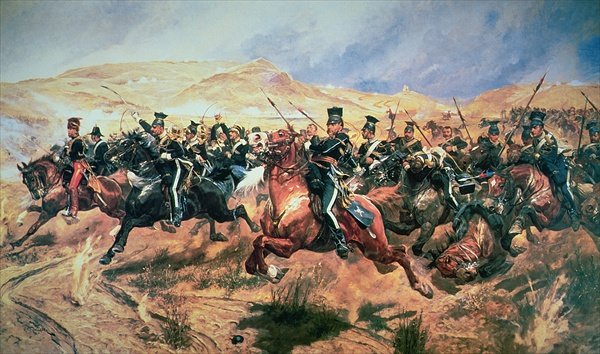Campbell Mellis Douglas, VC, army surgeon (born 5 August 1840 at Grosse Île, QC; died 31 December 1909 at Wells, England). After training as a doctor in Scotland, Douglas joined the British Army and served in Asia and Canada. In 1867, he led four soldiers through rough surf in a daring rescue of 17 sailors at Little Andaman Island in the Bay of Bengal. Douglas and his men received the Victoria Cross for their courage, one of only two times it was awarded for bravery not in the face of the enemy.

Early Life and Education
Campbell Douglas was the son of Dr. George Mellis Douglas and Charlotte Saxton Campbell. Between 1836 and 1864 (except for a two-year closure from 1861 to 1863), Dr. Douglas was the medical superintendent of the quarantine station on Grosse Île, Canada’s main immigration gateway for many years.
Campbell Douglas was educated at St. John’s College and Laval University, Quebec City. In 1858, he went to Scotland to attend Edinburgh University for medical training. Douglas qualified as a doctor in 1861.
British Army
On 1 October 1862, Campbell Douglas enrolled in the British Army as a probationary assistant surgeon and joined the 2nd Battalion, 24th Regiment of Foot (later the South Wales Borderers of Rorke’s Drift fame) on Mauritius on 22 May 1863. In 1865, he moved with his regiment to Rangoon, Burma (now Yangon, Myanmar).
By 1867, Douglas was an assistant surgeon. He was sent as medical officer with a detachment to Port Blair Prison in the Andaman Islands, which were then a protectorate of Burma.
In late April 1867, the ship Assam Valley had anchored at Little Andaman Island in the Bay of Bengal. A few of the crew went ashore and were attacked by some of the island’s indigenous people. When none of the crew returned to their ship after a few days, it was feared they had been killed.
To discover what had happened, the British chief commissioner in Burma ordered another ship to the island. A few crewmen landed there on 7 May. When they too were attacked, a rescue mission was organized to save them. By then, however, a huge storm was raging, and the sea was extremely rough.
Douglas and four privates from the 24th Regiment manned a gig, a light, fast, rowboat, and tried to reach the shore. They almost succeeded, but then water started to rapidly fill the gig, Douglas was forced to return to the ship. He quickly mounted a second attempt and succeeded in taking off five of the crew. Douglas then made a third trip and rescued the last 12 of the 13 marooned sailors; one had drowned in the surf.
Douglas made these trips through raging, treacherous surf, which could have capsized the small craft at any time. He stood at the bow, directing the four soldiers and balancing the boat by shifting from one leg to the other.
Douglas was awarded the Victoria Cross (VC) for acting “in an intrepid and seamanlike manner, cool to a degree, as if what he was doing was an ordinary act of everyday life.” The four privates also received the VC, one of only two occasions when the medal was awarded for bravery not in the presence of the enemy. Douglas also received the Silver Medal of Royal Humane Society for his courage.
Did you know?
The only other occasion when a VC was awarded for bravery not in the presence of the enemy also had a Canadian connection. On 9 June 1866, Private Timothy O’Hea, 1st Battalion, Rifle Brigade, single-handedly extinguished a fire on an ammunition train at Danville, Quebec.
Canada
On 31 August 1872, Campbell Douglas was posted to the Royal Artillery garrison in Halifax, Nova Scotia. On 10 October 1874, he married Eleanor Annie McMaster, the widow of assistant surgeon Valentine McMaster and daughter of Colonel John Burmeister, Royal Engineers.
McMaster had also received the VC, having been awarded it for his actions during the Indian Mutiny in 1857. (Although widely known as the Indian Mutiny or Sepoy Mutiny, some modern Indian historians refer to it as the First War of Independence.) Eleanor may be the only woman in history to have married two VC recipients. Eleanor had a son and a daughter to McMaster and had four sons and a daughter with Douglas.
On 28 April 1876, Douglas was promoted to surgeon major, and on 1 October 1882, he became honorary brigade surgeon as a lieutenant-colonel. He retired in July 1883 and settled on a farm at Lakefield, Ontario.

North-West Resistance
In 1885, the government recruited Campbell Douglas to command 1st Field Hospital during the North-West Resistance. To do so, he reverted to major.
Staff and supplies for the hospital were first sent by rail to Saskatchewan Landing on the South Saskatchewan River. There, they were to be loaded on the paddle steamer Northcote for shipment to Saskatoon. When the Northcote was slow to return from a trip, Douglas went to investigate.
Douglas set off in a 3.65-metre collapsible canoe of his design and soon found Northcote stranded on a sandbar. He carried on to Saskatoon, where he arrived in time to treat the wounded from the 3 May Battle of Fish Creek. Douglas stayed there and supervised the care of the wounded from the final battle of the Resistance at Batoche on 12 May.
Retirement
Campbell Douglas remained an enthusiastic canoeist and hoped to sell his collapsible to the army. He paddled almost 1,300 metres from Collingwood, Ontario, to Chicago and later down the Hudson River to New York City. He also crossed the English Channel single-handedly three times.
Douglas eventually sold his farm and returned to Britain on half pay. He was recalled and appointed depot medical officer at Berwick, Scotland. Douglas retired again in 1897 but then reenrolled to become depot medical officer at Perth, Scotland. He did this to finance his canoeing.
Douglas finally retired in 1902 as surgeon general with the honorary rank of brigadier. He died at his daughter’s home near Wells, Somerset, and was buried on 4 January 1910 in Wells Cemetery.
The Canadian War Museum holds Douglas’s VC.

 Share on Facebook
Share on Facebook Share on X
Share on X Share by Email
Share by Email Share on Google Classroom
Share on Google Classroom







